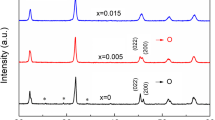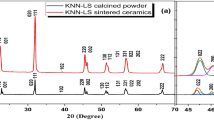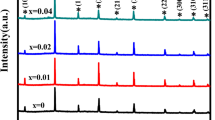Abstract
The formation of cation vacancies can be useful for electro-chemical devices. In this regard, an understanding of vacancy formation is an important subject for enhancing current electrochemical devices and for develo** next generation energy devices. In this work, we chose the well-known lead-free ferroelectric (K0.5Na0.5)NbO3 (KNN) as a model system to understand both the formation of cation vacancies and the relationship between cation vacancies and the physical properties. We studied sintering-duration dependence of the dielectric properties and the cation contents of KNN ceramics at the temperatures near the melting point of KNN. The difference in sintering duration led to a drastic change in the dielectric property, as well as to the creation of cation vacancies. Interestingly, we observed unequal evaporation of cations during the sintering process, which was confirmed by the data obtained from laser-induced breakdown spectroscopy. In addition, we found more drastic changes in the imaginary dielectric constant, which were likely due to a decrease in ionic conducting species, such as K and Na, in KNN.
Similar content being viewed by others
References
M. Li, J. Li, L-Q. Chen, B-L. Gu and W. Duan, Phys. Rev. B 92, 115435 (2015).
W. Li et al., Nature Phys. 8, 126 (2012).
N. Paunović et al., Nanoscale 4, 5469 (2012).
P. Chin Goh, K. Yao and Z. Chen, Appl. Phys. Lett. 99, 092902 (2011).
S. Dasgupta et al., Adv. Funct. Mater. 26, 7507 (2016).
J. Shi, Y. Zhou and S. Ramanathan, Nat. Commun. 5, 4860 (2014).
H. Jeen et al., Nat. Mater. 12, 1057 (2013).
K. A. Stoerzinger, W. S. Choi, H. Jeen, H. N. Lee and Y. Shao-Horn, J. Phys. Chem. Lett. 6, 487 (2015).
J. R. Petrie et al., Adv. Funct. Mater. 26, 1564 (2016).
J. Jeong et al., Science 339, 1402 (2013).
J. F. Li, K. Wang, F. Y. Zhu, L. Q. Cheng and F. Z. Yao, J. Am. Ceram. Soc. 96, 3677 (2013).
L. Liu et al., Mater. Chem. Phys. 117, 138 (2009).
B. Malič et al., Materials 8, 8117 (2015).
R. Guo et al., Phys. Rev. Lett. 84, 5423 (2000).
T. Furukawa, K. Ishida and E. Fukada, J. Appl. Phys. 50, 4904 (1979).
B. Jaffe, W. R. Cook and H. Jaffe, Piezoelectric ceramics (Academic Press, London, New York, 1971), p. 185.
T. R. Shrout and S. J. Zhang, J. Electroceram. 19, 113 (2007).
G. Ray, N. Sinha and B. Kumar, Mater. Chem. Phys. 142, 619 (2013).
S. Zhang, R. **a and T. R. Shrout, J. Electroceram. 19, 251 (2007).
Y-H. Lee, J-H. Cho, B-I. Kim and D-K. Choi, Jpn. J. Appl. Phys. 47, 4620 (2008).
P. Mahesh and D. Pamu, IOP Conf. Ser.: Mater. Sci. Eng. 73, 012 (2015).
R. Sumang, C. Wicheanrat, T. Bongkarn and S. Maensiri, Ceram. Int. 41, S136 (2015).
Y. Zhao, R. Huang, R. Liu, H. Zhou and W. Zhao, Curr. Appl. Phys. 13, 2082 (2013).
J. Acker, H. Kungl and M. J. Hoffmann, J. Am. Ceram. Soc. 93, 1270 (2010).
K. Wang and J-F. Li, J. Adv. Ceram. 1, 24 (2012).
Z-Y. Shen, K. Wang and J-F. Li, Appl. Phys. A 97, 911 (2009).
Y. Zhen and J. F. Li, J. Am. Ceram. Soc. 89, 3669 (2006).
D. Jenko, A. Bencan, B. Malic, J. Holc and M. Kosec, Microsc. Microanal. 11, 572 (2005).
D. Rusak, B. Castle, B. Smith and J. Winefordner, Crit. Rev. Anal. Chem. 27, 257 (1997).
D. W. Hahn and N. Omenetto, Appl. Spectrosc. 66, 347 (2012).
N. Wei, J. Wang, B. Li, Y. Huan and L. Li, Ceram. Int. 41, 9555 (2015).
H. Rietveld, J. Appl. Crystallogr. 2, 65 (1969).
B. Orayech, A. Faik, G. López, O. Fabelo and J. Igartua, J. Appl. Crystallogr. 48, 318 (2015).
K. Wang and J. F. Li, J. Am. Ceram. Soc. 93, 1101 (2010).
H. Du et al., Mater. Sci. Eng.: B 131, 83 (2006).
J. G. Fisher and S-J. L. Kang, J. Eur. Ceram. Soc. 29, 2581 (2009).
S. Priya and S. Nahm, Lead-free piezoelectrics (Springer-Verlag, New York, 2011), p. 87.
C. Fabre et al., Geochim. Cosmochim. Acta 66, 1401 (2002).
T. Kim, C. Lin and Y. Yoon, J. Phys. Chem. B 102, 4284 (1998).
A. Popovič, L. Bencze, J. Koruza and B. Malič, RSC Adv. 5, 76249 (2015).
A. B. Haugen, F. Madaro, L-P. Bjørkeng, T. Grande and M-A. Einarsrud, J. Eur. Ceram. Soc. 35, 1449 (2015).
R. López-Juárez, F. González and M-E. Villafuerte-Castrejón, Ferroelectrics-Material Aspects (InTech, México, 2011).
B. Malic, D. Jenko, J. Holc, M. Hrovat and M. Kosec, J. Am. Ceram. Soc. 91, 1916 (2008).
M. W. Chase, J. Curnutt, H. Prophet, R. McDonald and A. Syverud, J. Phys. Chem. Ref. Data 4, 1 (1975).
E. Ringgaard and T. Wurlitzer, J. Eur. Ceram. Soc. 25, 2701 (2005).
H. E. Mgbemere, M. Hinterstein and G. A. Schneider, J. Eur. Ceram. Soc. 32, 4341 (2012).
S. Huo, S. Yuan, Z. Tian, C. Wang and Y. Qiu, J. Am. Ceram. Soc. 95, 1383 (2012).
Y-J. Dai, X-W. Zhang and K-P. Chen, Appl. Phys. Lett. 94, 042905 (2009).
Author information
Authors and Affiliations
Corresponding author
Rights and permissions
About this article
Cite this article
Kim, G., Kong, H., Kim, D. et al. Thermally-driven unequal cation vacancy formation and its effect on the dielectric properties in K0.5Na0.5NbO3 ceramics. Journal of the Korean Physical Society 71, 979–985 (2017). https://doi.org/10.3938/jkps.71.979
Received:
Published:
Issue Date:
DOI: https://doi.org/10.3938/jkps.71.979




